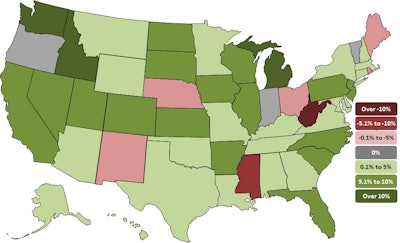
Construction firms added jobs in 40 states and the District of Columbia between April 2014 and April 2015 and in 30 states and D.C. between March and April, according to an analysis today of Labor Department data by the Associated General Contractors of America. Association officials said that even as construction employment continues to expand, workforce shortages and infrastructure funding challenges threaten future growth.
“The latest data show that construction is growing across most of the country but the gains remain uneven by month and state,” said Ken Simonson, the association’s chief economist. “Construction employment grew faster than overall employment in most states in the latest 12 months, but the industry faces two challenges: a lack of experienced workers in many locations and a risk that funding for highway and transit projects will lapse in the next few months.”
California added more new construction jobs (42,600 jobs, 6.4 percent) between April 2014 and April 2015 than any other state. Other states adding a high number of new construction jobs for the past 12 months included:
- Florida (32,200 jobs, 8.2 percent)
- Texas (25,300 jobs, 3.9 percent)
- Washington (18,700 jobs, 12 percent)
- Michigan (14,800 jobs, 10.6 percent)
Seven states shed construction jobs during the past 12 months while construction employment was unchanged in three states. West Virginia (-4,400 jobs, -13.1 percent) lost the highest total and percent of construction jobs. Other states that lost a high number of construction jobs for the year were:
- Mississippi (-3,200 jobs, -6.3 percent)
- Ohio (-3,000 jobs, -1.5 percent)
- Nebraska (-1,100 jobs, -2.3 percent)
- Rhode Island (-800 jobs, -4.8 percent)
Pennsylvania (10,000 jobs, 4.3 percent) added the most jobs between March and April, followed by:
- Minnesota (6,600 jobs, 6.3 percent)
- Virginia (5,000 jobs, 2.8 percent)
- New Jersey (3,400 jobs, 2.3 percent)
Eighteen states lost construction jobs during the past month, while construction employment was unchanged in Arizona and Utah. Texas (-5,400 jobs, -0.8 percent) lost the most construction jobs between March and April. Other states experiencing large monthly declines in total construction employment included:
- New York (-3,200 jobs, -0.9 percent)
- Florida (-2,300 jobs, -0.5 percent)
- West Virginia (-1,600 jobs, -5.2 percent)
Simonson observed that construction employment fell so far and for so long in most states that many veteran workers have left the industry for other sectors or have retired. While overall employment has been at record levels for more than a year, only five states have exceeded pre-recession highs for construction employment: Iowa, Louisiana, North Dakota, Oklahoma and South Dakota.
“Contractors are struggling to find workers with the right skills in states that had really deep losses in construction employment, such as Nevada, where employment remains 51 percent below the peak set in June 2006,” Simonson added.
















